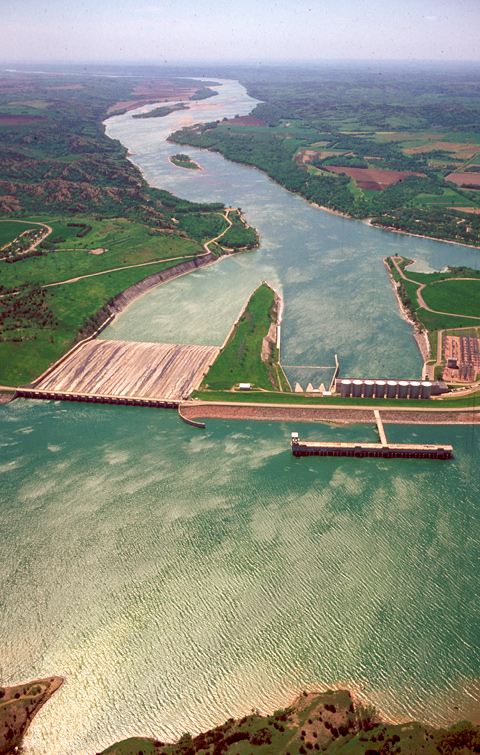Begun in 1946 and completed ten years later, Fort Randall Dam is one of four flood and irrigation control structures built on the Missouri River within the state of South Dakota; two more are in North Dakota. The reservoir that it impounds (beginning at the bottom of this photo) is known as Lake Frances Case; it reaches almost all the way to Big Bend Dam, 109 river miles upstream. The reservoir was named for Francis Higbee Case (1896-1962), a newspaperman who served the people of South Dakota in both houses of the United States Congress for a total of 25 years. Sen. Case devoted much of his legislative energy toward improving the transportation and commercial infrastructure throughout the U.S., especially highways and waterways.
The dam was named after the historic Fort Randall military post that was built in 1856 a short distance downriver, and served as a strategic supply and mustering center until it was decommissioned in 1892. The fort’s namesake was Col. Daniel Randall (1790-1851), a Deputy Paymaster of the Army. The nearest community to Fort Randall Dam is Pickstown, South Dakota (population 182), which was named after Lieutenant General Lewis A. Pick (1890-1956), the director of the Missouri River Department of the U.S. Army Corps of Engineers, the agency that built all six of the Missouri River dams. The next structure downriver is Gavins Point Dam, only 60 river miles southeast, which impounds Lewis and Clark Lake.
The Corps’ camp on the night of 7 September 1804 was perhaps near the river’s bend at the horizon in the photograph above. On the 8th, they sailed before a “gentle Breese” past an abandoned trading post built nine years earlier by a French Canadian, Jean Baptiste Truteau, whose house stood on the plain at left of the dam’s spillway.
Sergeant Gass reported a curious little farce that had played out on nature’s stage. That morning he went out with one of the hunters to retrieve the meat and hide of a buffalo the man killed the previous evening. The hunter had left his hat on the carcass “to keep off the vermin and beasts of prey,” apparently believing the scent of a human would scare them away. “But when we came to the place,” Sgt. Gass continued, “we found the wolves had devoured the carcase and carried off the hat.”
From Discovering Lewis & Clark from the Air Photography by Jim Wark Text by Joseph Mussulman Reproduced by permission of Mountain Press
Experience the Lewis and Clark Trail
The Lewis and Clark Trail Experience—our sister site at lewisandclark.travel—connects the world to people and places on the Lewis and Clark Trail.
Discover More
- The Lewis and Clark Expedition: Day by Day by Gary E. Moulton (University of Nebraska Press, 2018). The story in prose, 14 May 1804–23 September 1806.
- The Lewis and Clark Journals: An American Epic of Discovery (abridged) by Gary E. Moulton (University of Nebraska Press, 2003). Selected journal excerpts, 14 May 1804–23 September 1806.
- The Lewis and Clark Journals. by Gary E. Moulton (University of Nebraska Press, 1983–2001). The complete story in 13 volumes.


